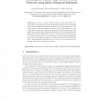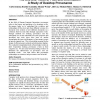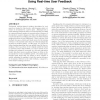779 search results - page 73 / 156 » Determining Time of Queries for Re-ranking Search Results |
ADBIS
2006
Springer
14 years 4 months ago
2006
Springer
In order to search similar moving object trajectories, the previously used methods focused on Euclidean distance and considered only spatial similarity. Euclidean distance is not a...
CHI
2010
ACM
13 years 8 months ago
2010
ACM
In the field of Human-Computer Interaction, provenance refers to the history and genealogy of a document or file. Provenance helps us to understand the evolution and relationships...
CIKM
2010
Springer
13 years 8 months ago
2010
Springer
Traditional machine-learned ranking algorithms for web search are trained in batch mode, which assume static relevance of documents for a given query. Although such a batch-learni...
DELOS
2000
13 years 11 months ago
2000
User feedback has proven very successful to query large multimedia databases. Due to the nature of the data representation and the mismatch between mathematical models and human p...
BMCBI
2007
13 years 10 months ago
2007
Background: In proteomic analysis, MS/MS spectra acquired by mass spectrometer are assigned to peptides by database searching algorithms such as SEQUEST. The assignations of pepti...



